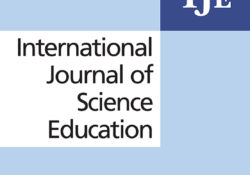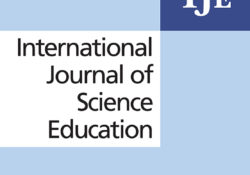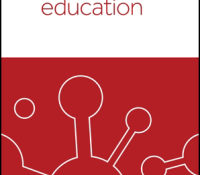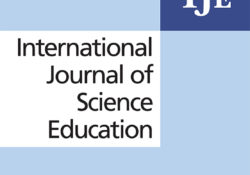tandfonline.com har udgivet en rapport under søgningen “Teacher Education Mathematics”: ABSTRACT ABSTRACT Background: To make students more interested and engaged in science, new teaching approaches have been developed aiming at higher order thinking. Context-based learning approaches emanate from an idea that science content knowledge should be presented in a relevant context for students to improve their learning outcomes as well as making them more engaged in science. Previous research on context-based learning approaches has shown positive results; however, researchers and teachers need to explicitly consider which aspects of the contextual settings young students perceive as interesting and relevant to improve chemistry education. Purpose: In this paper, the constructs of ‘interest’ and ‘relevance’ are explored to analyse which aspects of open-ended chemistry problems engage students. Sample and Design: Both qualitative interview… Continue Reading →
Like this:
Like Loading...
tandfonline.com har udgivet en rapport under søgningen “Teacher Education Mathematics”: ABSTRACT ABSTRACT This study investigated the time effect of cooperative games on students’ emotions of learning science and the treatment effect on their chemistry achievement. This quasi-experimental study compared the use of cards, board games, and riddles, and the use of conventional paper-and-pencil exercises to learn the basics of chemical elements and compounds, for a duration of 4 weeks. One hundred and fourteen ninth graders at an urban public high school in Taipei were involved. The results revealed that the experimental group had significantly higher positive emotion and lower negative emotion throughout the intervention period. While no time effect was observed for the experimental group, a significant time effect on positive and negative emotions in the comparison group using exercises… Continue Reading →
Like this:
Like Loading...

tandfonline.com har udgivet en rapport under søgningen “Teacher Education Mathematics”: ABSTRACT ABSTRACT Getting students to understand the particulate nature of matter is a major challenge for chemistry education. In upper secondary school students commonly struggle to distinguish between intra- and intermolecular bonding and analyse chemical bonding in terms of electronegativity. In this study, we explore how creative drama may be used in chemistry education to facilitate students’ explorations of electronegativity and chemical bonding in Swedish upper secondary chemistry education. The study was conducted as a design-based intervention in three cycles in two schools. The interventions (which lasted for 30–60 minutes) were single-lesson-interventions consisting of drama activities and discussions in whole-class and student groups. A qualitative content analysis produced themes that captured the ways in which the students explored electronegativity and… Continue Reading →
Like this:
Like Loading...
tandfonline.com har udgivet en rapport under søgningen “Teacher Education Mathematics”: ABSTRACT ABSTRACT The traditional description of “the scientific method” as a stepwise, linear process of hypothesis testing through experimentation is a myth. Although the teaching and learning of the scientific method have been a curriculum and assessment goal, the notion of the ‘scientific method’ itself has been identified as being problematic. Many researchers have recognised there is no single scientific method. However, there does not seem to be any useful guidelines for how best to deal with the nature of scientific methods in school science, including in high-stakes summative assessment. The article presents the use of a framework to illustrate the diversity of scientific methods that goes beyond the traditional limitations of a scientific method, to provide a more comprehensive… Continue Reading →
Like this:
Like Loading...
tandfonline.com har udgivet en rapport under søgningen “Teacher Education Mathematics”: ABSTRACT ABSTRACT Context-based learning aims to make learning more meaningful by raising meaningful problems. However, these types of problems often require reflection and thinking processes that are more complex and thus more difficult for students, putting high demands on students’ problem-solving capabilities. In this paper, students’ approaches when solving context-based chemistry problems and effects of systematic scaffolds are analysed based on the Model of Hierarchical Complexity. Most answers were initially assigned to the lowest level of the model; higher levels were reached without scaffolds only by few students and by most students with scaffolds. The results are discussed with regard to practical implications in terms of how teachers could make use of context-based tasks and aligned scaffolds to help students… Continue Reading →
Like this:
Like Loading...
eric.ed.gov har udgivet: The challenges of education in the era of the industrial revolution include disruption 4.0, 21st-century skills, globalization, and global competition. Chemistry is a subject that needs to be developed in order to improve the educational system in the era of disruption. The purpose of this research is to identify and analyze the needs of the media-based chemistry study ICT at grade X redox materials in State Senior Highschool 8 Semarang during the disruption. The method used in this research is a descriptive qualitative method which consists of the study of literature and the study of the field. Method of data collection is done through observation, question form, documentation, interview teachers, as well as interview students. This research instrument consisting of a sheet of observation, question form, and… Continue Reading →
Like this:
Like Loading...
tandfonline.com har udgivet en rapport under søgningen “Teacher Education Mathematics”: Abstract Formulae display:?Mathematical formulae have been encoded as MathML and are displayed in this HTML version using MathJax in order to improve their display. Uncheck the box to turn MathJax off. This feature requires Javascript. Click on a formula to zoom. Abstract Technological innovation in science provides complementary tools for exploring new teaching strategies within a pedagogical framework that promotes interaction between the teacher and the learner. This work is based on the implementation of a computer application modeling crystallographic material structures, in order to identify and study the different crystalline structures and their characteristics, based on the techniques of three-dimensional modeling covering the OpenGL library and the Euler rotation matrices, and developed by the C # programming language. The… Continue Reading →
Like this:
Like Loading...
tandfonline.com har udgivet en rapport under søgningen “Teacher Education Mathematics”: ABSTRACT ABSTRACT In this study, we explore the issues and challenges involved in supporting students’ learning to discern relevant and critical aspects of determining oxidation states of atoms in complex molecules. We present a detailed case of an interaction between three students and a tutor during a problem-solving class, using the analytical tool of practical epistemology analysis (PEA). The results show that the ability to make relevant distinctions between the different parts of a molecule for solving the problem, even with the guidance of the tutor, seemed to be challenging for students. These shifts were connected to both purposes that were specific for solving the problem at hand, and additional purposes for general learning of the subject matter, in this… Continue Reading →
Like this:
Like Loading...
tandfonline.com har udgivet en rapport under søgningen “Teacher Education Mathematics”: ABSTRACT ABSTRACT An upper-year undergraduate practical examination is presented that utilizes the EcoScale (a semi-quantitative tool) and several established mass metrics to assess student understanding of green chemistry principles. This activity focuses on the straightforward preparation of a benzodiazepine via three different catalytic methods, and the analysis of individual experimental data during laboratory time. Students learn about the structure of the EcoScale, apply it as a simplistic life cycle assessment, and critique it as a scientific model. The examination complements more traditional expository and self-design experiments within a synthetic course where green chemistry and sustainability are central themes. GRAPHICAL ABSTRACT Link til kilde
Like this:
Like Loading...
eric.ed.gov har udgivet: The aim of this case-study was to understand how chemistry teachers experience their work in diverse classes where the needs of differentiated teaching practices are constantly growing. The deeper intention was to perceive new information in order to develop supportive methods that could better correspond to teachers’ reality. Eight voluntary Finnish secondary school chemistry teachers participated in semi-structured interviews. Four categorial distinctions for successful chemistry teaching were found according to their beliefs: 1) to have more support and resources, 2) to be able to recognize students’ problems, 3) to use supportive materials and methods, and 4) to connect theory and practice with inspiring and meaningful activities. This study presents new insights about teachers’ beliefs of diversity and what is needed for successful chemistry teaching. Directions for further… Continue Reading →
Like this:
Like Loading...







